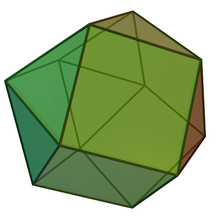Disheptahedron
A disheptahedron (also anti- cuboctahedron ) is a polyhedron that consists of the same surfaces as the cuboctahedron , i.e. those of a hexahedron (cube) and an octahedron . In the alternative name (anti-cubooctahedron) there are the words cube and octahedron . It is also known as the Johnson body J 27 (triangular double dome (twisted cuboctahedron)).
description
A disheptahedron is obtained from a cuboctahedron by cutting along the plane that forms a circumferential edge between the hexahedron and the octahedron, and then rotating both halves by 180 ° against each other. As a result, in the disheptahedron, 3 groups of 2 hexahedron and 2 octahedron faces each have a common edge. The previous cutting plane becomes a mirror plane of the body.
With 14 surfaces (8 equilateral triangles and 6 squares ), 12 corners and 24 edges of the same length, Euler's polyhedron substitution is fulfilled exactly as with the cuboctahedron.
Formulas
| Sizes of a disheptahedron with edge length a | |
|---|---|
| volume | |
| Surface area | |
| Umkugelradius | |
| Edge ball radius | |
|
3D edge angle = 120 ° |
|
Occurrence
The disheptahedron is used in structural chemistry and crystallography as a coordination polyhedron (e.g. in the hexagonal closest packing of spheres hcp ). The associated coordination number is (just like with the cuboctahedron) 12; the limiting radius quotient is also 1.
Web links
- Eric W. Weisstein : Disheptahedron . In: MathWorld (English).
- beuth-hochschule.de (PDF) p. 7






